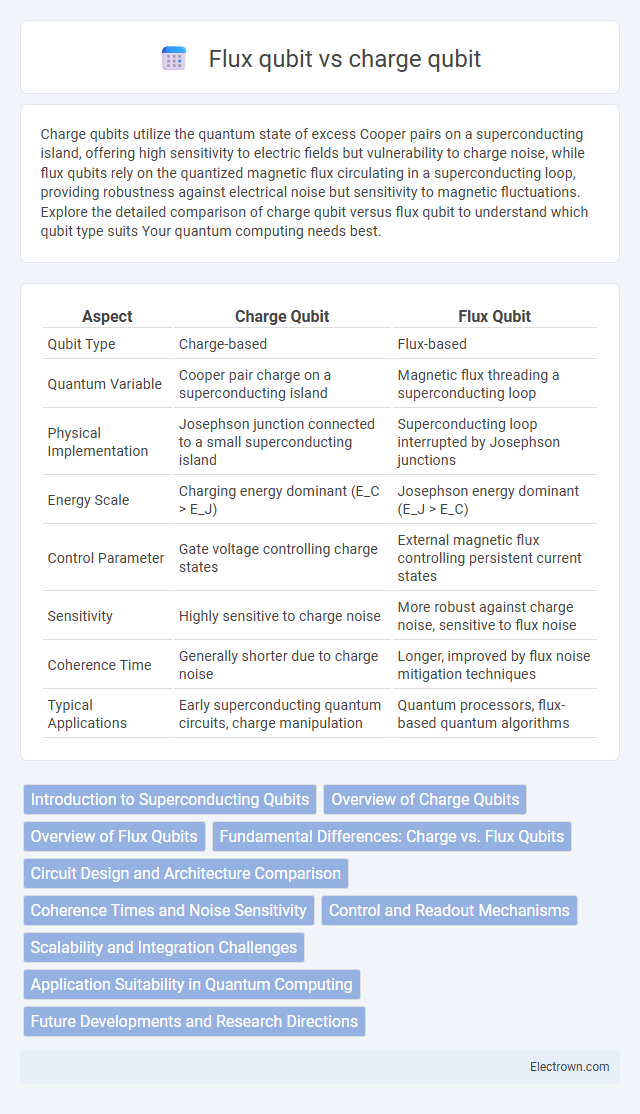Charge qubits utilize the quantum state of excess Cooper pairs on a superconducting island, offering high sensitivity to electric fields but vulnerability to charge noise, while flux qubits rely on the quantized magnetic flux circulating in a superconducting loop, providing robustness against electrical noise but sensitivity to magnetic fluctuations. Explore the detailed comparison of charge qubit versus flux qubit to understand which qubit type suits Your quantum computing needs best.
Table of Comparison
| Aspect | Charge Qubit | Flux Qubit |
|---|---|---|
| Qubit Type | Charge-based | Flux-based |
| Quantum Variable | Cooper pair charge on a superconducting island | Magnetic flux threading a superconducting loop |
| Physical Implementation | Josephson junction connected to a small superconducting island | Superconducting loop interrupted by Josephson junctions |
| Energy Scale | Charging energy dominant (E_C > E_J) | Josephson energy dominant (E_J > E_C) |
| Control Parameter | Gate voltage controlling charge states | External magnetic flux controlling persistent current states |
| Sensitivity | Highly sensitive to charge noise | More robust against charge noise, sensitive to flux noise |
| Coherence Time | Generally shorter due to charge noise | Longer, improved by flux noise mitigation techniques |
| Typical Applications | Early superconducting quantum circuits, charge manipulation | Quantum processors, flux-based quantum algorithms |
Introduction to Superconducting Qubits
Superconducting qubits, including charge qubits and flux qubits, form the foundation of quantum computing by utilizing superconducting circuits to represent quantum information. Charge qubits operate based on the quantized charge states of Cooper pairs on a superconducting island, offering fast manipulation but sensitivity to charge noise. Flux qubits rely on persistent current states circulating in a superconducting loop, providing robustness against charge fluctuations and enabling longer coherence times for your quantum experiments.
Overview of Charge Qubits
Charge qubits are superconducting quantum bits where the computational basis states are defined by the presence or absence of Cooper pairs on a superconducting island. Their quantum state is highly sensitive to electric charge fluctuations, making them well-suited for fast operations but prone to decoherence from charge noise. Typically implemented using Cooper pair boxes connected to Josephson junctions, charge qubits enable precise control through gate voltages to manipulate charge states.
Overview of Flux Qubits
Flux qubits are superconducting loops interrupted by Josephson junctions, exploiting quantized magnetic flux states to encode quantum information with high coherence times. These qubits are controlled by external magnetic fields, allowing precise manipulation of the quantum states corresponding to clockwise or counterclockwise persistent currents. Flux qubits offer robustness against charge noise, making them promising candidates for scalable quantum computing architectures focused on magnetic flux degree of freedom.
Fundamental Differences: Charge vs. Flux Qubits
Charge qubits utilize the quantized charge states of Cooper pairs on a superconducting island, making them highly sensitive to electric charge fluctuations. Flux qubits rely on the quantized magnetic flux through a superconducting loop, measuring persistent current states and exhibiting robustness against charge noise. Your choice between these qubit types depends on the desired balance between sensitivity to charge versus magnetic flux, impacting coherence times and operational control.
Circuit Design and Architecture Comparison
Charge qubits utilize superconducting islands connected by Josephson junctions, where the quantum state is defined by the number of Cooper pairs, enabling precise charge control but making them sensitive to charge noise. Flux qubits consist of superconducting loops interrupted by Josephson junctions, with their quantum states encoded in the direction of persistent current, offering robustness against charge fluctuations but increased sensitivity to magnetic flux noise. The fundamental architectural difference lies in charge qubits prioritizing capacitive energy, whereas flux qubits emphasize inductive energy, dictating distinct circuit designs optimized for their respective quantum operations.
Coherence Times and Noise Sensitivity
Charge qubits exhibit shorter coherence times due to pronounced sensitivity to charge noise, which leads to rapid decoherence from fluctuating electric fields. Flux qubits benefit from longer coherence times because their states are defined by magnetic flux, making them less vulnerable to charge noise but more sensitive to flux noise from magnetic fluctuations. Engineering improvements such as materials optimization and noise filtering have enhanced coherence times for both types, yet flux qubits generally maintain superior noise resilience in superconducting quantum circuits.
Control and Readout Mechanisms
Charge qubits utilize gate voltages to control the number of Cooper pairs on a superconducting island, allowing precise manipulation of quantum states through electrostatic means. Flux qubits employ magnetic flux threading a superconducting loop, with control achieved by adjusting external magnetic fields to modulate persistent current states. Your readout in charge qubits typically involves single-electron transistors or quantum point contacts detecting charge states, while flux qubits often use DC SQUIDs (Superconducting Quantum Interference Devices) to measure circulating currents indicative of quantum states.
Scalability and Integration Challenges
Charge qubits face scalability challenges due to their sensitivity to charge noise, which complicates error correction and stable multi-qubit integration. Flux qubits offer better noise resilience, enabling more reliable coupling in larger arrays, but they require intricate magnetic flux control that limits seamless integration in complex circuits. Optimizing your quantum computing architecture demands balancing these trade-offs to achieve scalable, high-fidelity qubit networks.
Application Suitability in Quantum Computing
Charge qubits excel in applications requiring fast quantum gate operations and high control precision, making them suitable for quantum algorithms dependent on rapid state manipulation. Flux qubits demonstrate superior coherence times and resilience to charge noise, fitting applications where long qubit stability and robust error correction are essential. The choice between charge and flux qubits depends on balancing gate speed against coherence duration for optimized performance in diverse quantum computing architectures.
Future Developments and Research Directions
Future developments in charge qubits emphasize increasing coherence times through improved materials and fabrication techniques to mitigate charge noise. Flux qubits research focuses on enhancing flux noise resistance and integrating topological protection methods to achieve fault-tolerant quantum computing. Emerging hybrid qubit architectures combining charge and flux properties aim to leverage the advantages of both for scalable quantum processors.
charge qubit vs flux qubit Infographic

 electrown.com
electrown.com